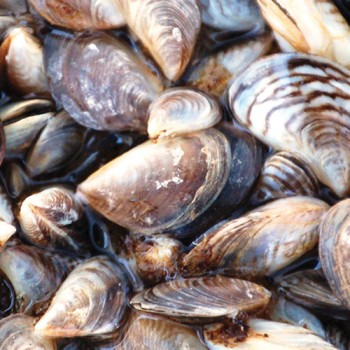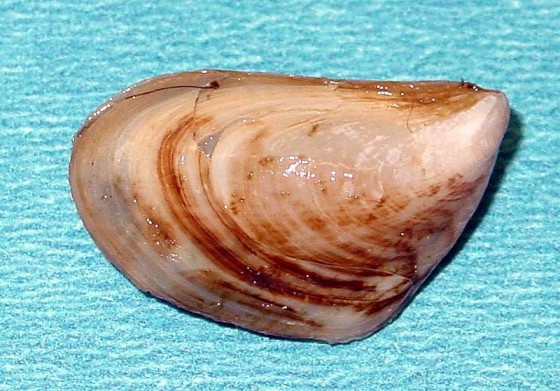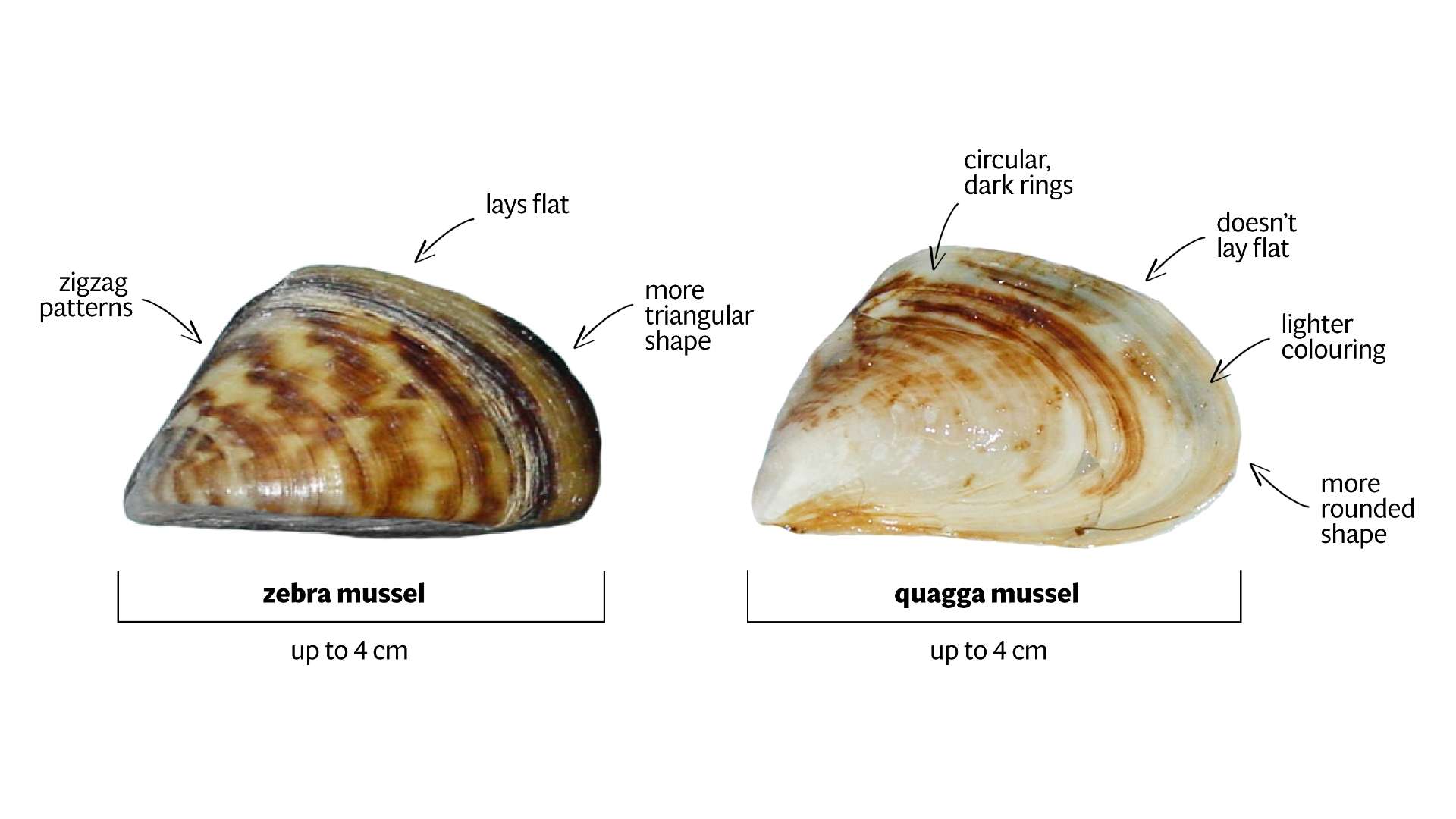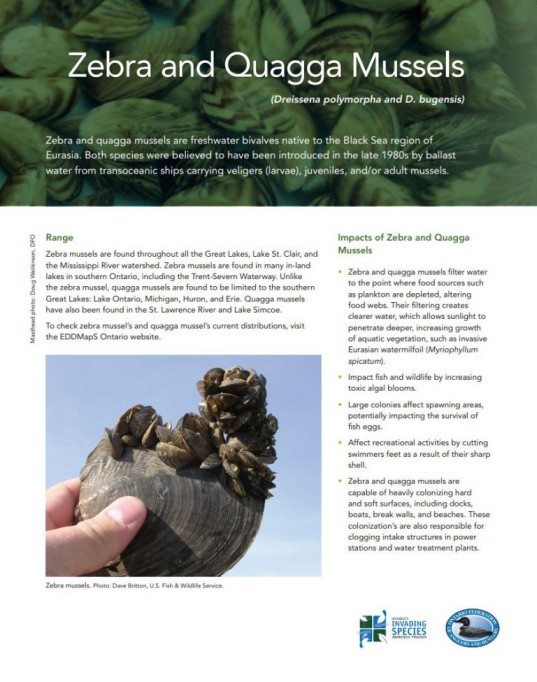Zebra/Quagga mussels found in moss ball products across Canada: Learn proper disposal and reporting.
Learn more here.
Zebra and Quagga Mussels (Dreissena polymorpha)
French common name: Les moules zébrée et quaggua

Zebra Mussels

Quagga Mussels
When placed on a flat surface, zebra mussels are stable on their flattened underside while quagga mussels, lacking a flat underside, will fall over.
Order: Myida
Family: Dreissenidae
Zebra and quagga mussels are invasive freshwater mussels that can be found throughout Ontario, Quebec, and Manitoba. Native to the Black Sea region of Eurasia, they arrived in the Great Lakes via ballast water in the larval (veliger) stage and have spread throughout North America. These invasive mussels filter plankton out of the water, which depletes it as a food source for native species. Large colonies can take over fish spawning areas and beaches, cutting the feet of potential swimmers. They also clog water intake lines because of their dense colonies. Zebra and quagga mussels can reduce water quality as they can increase the presence of toxic algal blooms, which can have health impacts on native wildlife. They latch on to boats and can be easily spread between water bodies. Ensure that all plants, animals, and mud are removed from boats and trailers before leaving an area to help prevent the spread of aquatic invaders.
The zebra mussel is a small freshwater mussel named for the striped pattern of its shell. However, color patterns can vary to the point of having only dark or light-colored shells with no stripes. This mussel is typically found attached to objects, surfaces, or other mussels by byssal threads extending from underneath the shells. When placed on a surface, zebra mussels are stable on their flattened underside.
Although similar in appearance to the zebra mussel, the two species can be distinguished by their shell morphology. When placed on a surface, zebra mussels are stable on their flattened underside while quagga mussels, lacking a flat underside, will fall over. Quagga mussels are more round in shape and have more concentric rings as opposed to the striped pattern of a zebra mussel.

The introduction of zebra and quagga mussels into the Great Lakes is the result of water discharge from transoceanic ships that were carrying veligers (larvae), juvenile, or adult mussels. Although adult mussels move very little, they produce larvae that are free-floating in the water. This mobile larval stage contributes to their rapid dispersal. Adult mussels can attach to boats and barges that navigate the waterways, and in this way, can allow them to be easily transported between water bodies.
Zebra mussels were first discovered in the Great Lakes in 1986 in Lake St. Clair and quagga mussels were first discovered in 1989 near Lake Erie. They have since spread throughout the Great Lakes (except Lake Superior, as nutrient availability doesn’t support mussel survival) and many in-land lakes in Ontario, Quebec, Manitoba and the U.S.
Ecological impacts of invasive mussels
Zebra and quagga mussels can have large impacts on the ecosystems they invade. They primarily consume phytoplankton, but other suspended material is filtered from the water as well. This reduces the plankton availability for other organisms, and effects can be seen throughout the food web. This filtering also increases the amount of sunlight able to penetrate the water, promoting algal blooms and leading to decreased water quality. Invasive mussels also attach to the shells of native species, suffocating populations of already threatened populations of freshwater mussels.
Invasive mussels also retain toxins as they filter the water, which can lead to botulism in mussel-eating fish and waterfowl.
While zebra mussels are limited to colonizing hard surfaces, quagga mussels can also colonize on soft substrates. They are also able to survive in low-food environments, so when both species co-exist, quagga mussels are the dominant species and are able to out-compete zebra mussels.
New research suggests invasive mussels are playing a role in the phosphorus cycle in lakes Huron, Erie, Michigan and Ontario which causes uncertainty and variability in these levels. This could have impacts on the phytoplankton communities to large predatory fish.
Economic Impacts of invasive mussels
Their ability to rapidly colonize surfaces causes serious economic problems. Invasive mussels can clog water intake structures, such as pipes and screens, therefore reducing pumping capabilities for power and water treatment plants and posing costs to industries, companies, and communities. Recreation-based industries and activities have also been impacted; docks, breakwalls, buoys, boats, cottage intake pipes, and beaches have all been heavily colonized.
Impacts of quagga mussels on infrastructure
This species ability to rapidly colonize hard surfaces causes serious economic problems. These major biofouling organisms can clog water intake structures, such as pipes and screens, therefore reducing pumping capabilities for power and water treatment plants and posing costs to industries, companies, and communities. Recreation-based industries and activities have also been impacted; docks, breakwalls, buoys, boats, and beaches have all been heavily colonized. Quaggas are able to colonize both hard and soft substrata, so their negative impacts on native freshwater mussels, invertebrates, industries and recreation are unclear.
Impacts of zebra mussels on infrastructure
Zebra mussels are notorious for their biofouling capabilities by colonizing water supply pipes of hydroelectric and nuclear power plants, public water supply plants, and industrial facilities. They colonize pipes, constricting flow, and therefore reducing the intake in heat exchangers, condensers, fire fighting equipment, and air conditioning and cooling systems. Zebra mussel densities were as high as 700,000/m2 at one power plant in Michigan and the diameters of pipes have been reduced by two-thirds at water treatment facilities. Navigational and recreational boating can be affected by increased drag due to attached mussels. Small mussels can get into engine cooling systems causing overheating and damage. Navigational buoys have been sunk under the weight of attached zebra mussels. Fishing gear can be fouled if left in the water for long periods.
Fact Sheets
Best Management Practices

Lorem ipsum dolor sit amet, consectetur adipiscing elit. Ut elit tellus, luctus nec ullamcorper mattis, pulvinar dapibus leo.
Articles
Zebra versus quagga mussels: a review of their spread, population dynamics, and ecosystem impacts
continue to spread in Europe and in North America, and have large ecological and
economic impacts where they invade. Today many more waterbodies are invaded by zebra …
[BOOK] Quagga and zebra mussels: biology, impacts, and control
(Nalepa and Schloesser 1993), it was only a few years after this species had been reported
in North America, and our intention was to document initial impacts, summarize control …
Invasion of zebra mussel, Dreissena polymorpha, in Lake Simcoe
biomass of zebra mussels in Lake Simcoe. Pumped water samples, multi-plate tower
samplers, and scuba and benthic airlift surveys were used to sample veligers, post-veligers …
Current Research and Knowledge Gaps
Lorem ipsum dolor sit amet, consectetur adipiscing elit. Ut elit tellus, luctus nec ullamcorper mattis, pulvinar dapibus leo.
Further Reading
The Invasive Species Centre aims to connect stakeholders. The following information below link to resources that have been created by external organizations.

